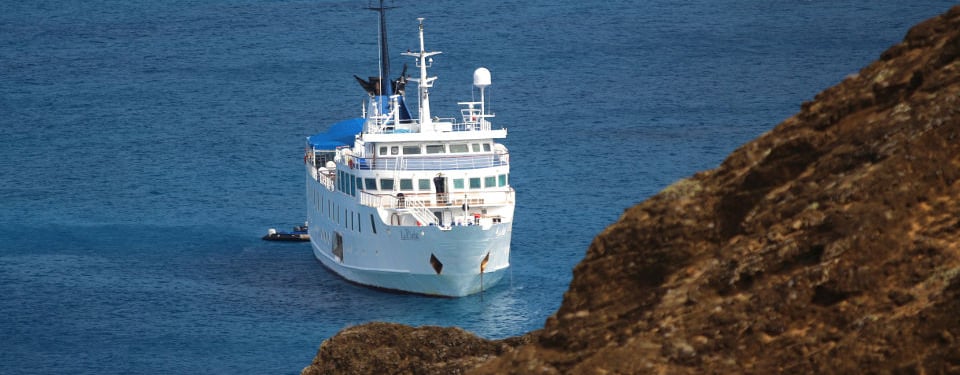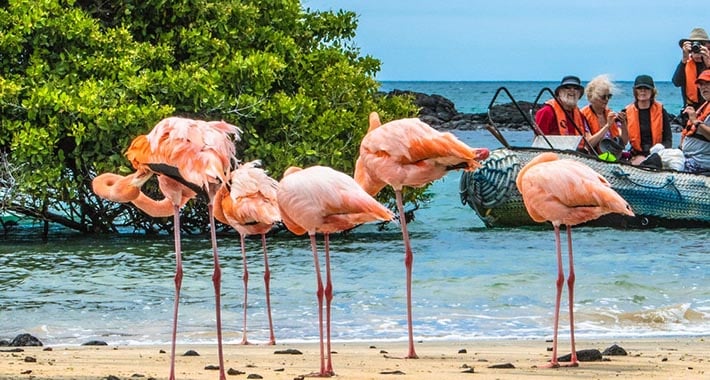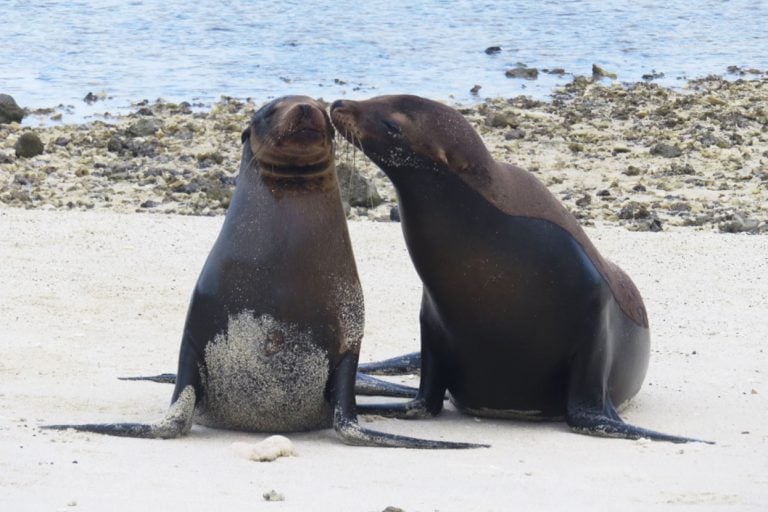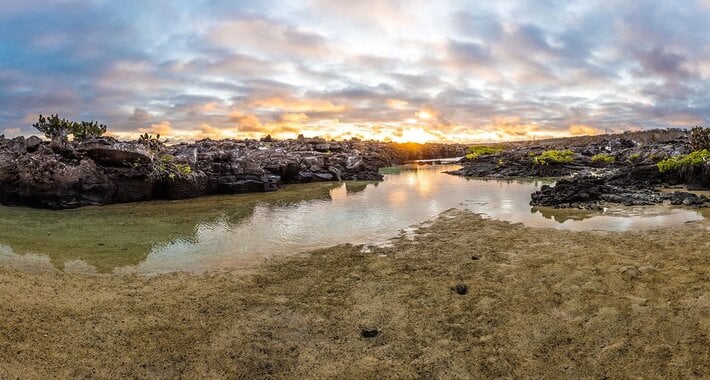What’s the true difference between a Catamaran and an Expedition Vessel in the Galapagos?

Admittedly, there’s an allure about catamarans that is undeniably sleek, contemporary, appealing, and, dare we say it, seductive. Catamarans almost seem to be made for the oceans they sail on, with features like their futuristic double hulls, arching belly, and sharp bows that give them the appearance of a magnificent spaceship. For a change, let’s pause to consider the wider picture and consider this: in an area as remote and prone to doldrums as the Galapagos, what real utility can catamarans serve?
Join us on this blog as we discuss the advantages and disadvantages of using catamarans in the Galapagos, particularly in light of the significant advantages of choosing an expedition vessel with a single hull, or monohull.
Yacht La Pinta is an Expedition Vessel designed to bring you full comfort during a Galapagos vacation.
Get ready for your Galapagos tour!
The Drawbacks of Catamaran Travel in the Galapagos Islands
First issue: Low roll and high pitch while using catamarans in the Galapagos
The main drawback to catamarans is that you will noticeably oscillate in pitch, even if you are sailing with the breeze and may very well be experiencing very little roll. Put differently, when traveling over water, catamarans often wind up “slapping the sea” due to their tendency to have their front ends repeatedly lift up and down, making for an unpleasant ride. What’s more? One hull may occasionally lift up higher than the other in turbulent conditions, which is not conducive to a smooth ride at all. Conversely, single-hull expedition vessels blend in with their environment instead of continuously attempting to outmaneuver it.
Sailing around the Galapagos in complete luxury is the goal of the expedition vessel Yacht La Pinta.
Another thing to keep in mind is that if a wave hits a catamaran from the side, it will hit you twice since the wave will impact both hulls instead of just one. When sailing in stormy weather, a catamaran may really seem a lot more like a rollercoaster ride. Furthermore, while traveling to a once-in-a-lifetime location like the Galapagos, who wants to spend their sleep on a rollercoaster?
A further design issue exists when passenger cabins are located within the hull, which is the least stable component of the catamaran, but public areas are located on the spanning bridge, which is the most stable part.
Second issue: Using catamarans in the Galapagos with size and zero wind
In the Galapagos, most catamarans are quite tiny and can accommodate no more than 16 people. As such, it’s not unusual to feel a little claustrophobic while traveling in the Galapagos in catamarans.
But maybe the most crucial lesson to learn from knowing the drawbacks of the catamaran in the Galapagos is this: You have to understand that the Galapagos is essentially associated with the doldrums, which is to say that there aren’t many breezes in the area (especially from January to April, when there are almost none). Consequently, wind will never be used to propel catamarans in the Galapagos. In that instance, how near will you actually be to the engines considering their modest size? Keep in mind that a lot of ships cruise at night, so you could find that the deafening boom of the engines keeps you awake at night.
The Galapagos Islands’ Advantages of Catamarans
Catamarans are designed with a purpose, and that purpose mostly relates to their stability and speed. The catamarans reduce their water displacement by having two hulls rather than one, which essentially means they have to “push up against” significantly less water when navigating.
Still, there’s only one situation in which sailing a catamaran will make a discernible and advantageous difference: when the wind is blowing from behind you. Catamarans will stay stable and offer you a lot less roll under these ideal—possibly the only—conditions since you’re essentially traveling along a route with less resistance. In the event that this isn’t the case (that is, if you wish to proceed in any direction other than the direction of the wind), as you will see in the next section, you will encounter issue #1 when sailing catamarans in the Galapagos.
Catamarans are typically superior at handling the seas—but only while sailing against the wind and currents. But it’s crucial to remember that you’re not always sailing with the wind when in the Galapagos. As any cruise should, if they want to provide their customers with great island coverage, you will, in fact, be sailing in ALL directions a lot of the time in the Galapagos.
The Advantages of Taking a Trip on One of Our Expedition Ships
Our expedition ships in the Galapagos are substantially larger. There’s plenty of space for you to spread out and unwind on Yacht Isabela II, Santa Cruz II or La Pinta. Another point is that, in general, a longer boat makes for a steadier voyage when sailing at sea. Additionally, we only go at night and steer clear of waves that result in higher movements by avoiding them as much as possible.
Most significantly, though, is that we try to shield our visitors from any noises caused by humans by providing buffer decks. Our visitors may stay well-insulated and protected from the noise of the engines on our boats thanks to these buffer decks.
As opposed to wayward sides, our single-hull expedition ships in the Galapagos anchor on the leeward side of the islands, keeping us mostly protected from crosswinds.
Another thing to think about is that because our expedition vessels are bigger, we have more guides on board, which results in a lower guest-to-guide ratio (usually no more than 10 guests per guide, far less than the 15 guests per guide maximum that the National Park allows).
Choices, Choices..
In fact, the decision frequently comes down to personal taste and the intended use of the vessel. Nonetheless, it’s important to keep in mind that there are no real advantages to sailing a catamaran due to the peculiar circumstances in the Galapagos. A catamaran could be a viable option if you’re not sailing against the wind and aren’t dealing with currents coming from all directions, which is basically not fighting the ocean to keep your vessel on course. However, choosing such a sleek and elegant vessel would not be the best option in a place as rare and unique as the Galapagos, where there is hardly no wind and smaller catamarans could cause persistent engine noise all night. In the Galapagos, comfort is frequently subordinated to style when it comes to catamarans.
We heartily urge you to think about booking a trip aboard a single-hull adventure ship in the Galapagos, such the Yacht La Pinta or the Yacht Isabela II. Don’t wait to reserve your Galapagos tour right now!
RELATED STORIES

What are the best birds to see in the Galapagos?

Six Stunning Ways Galapagos Island Animal Mothers Nurture Their Young

Guy Fawkes on the Galapagos Islands: Never forget the November “Finch”…

A Unique 6-Day Insular Inspiration Session with Charles Darwin on Santiago Island!
